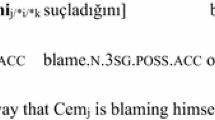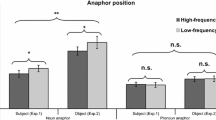Abstract
When reading sentences with an anaphoric reference to a subject antecedent, repeated-name anaphors result in slower reading times relative to pronouns (the Repeated Name Penalty: RNP), and overt pronouns are read slower than null pronouns (the Overt Pronoun Penalty: OPP). Because in most languages previously tested, the grammatical subject is typically also the discourse topic it remains unclear whether these effects reflect anaphors’ subject-hood or their topic-hood. To address this question we conducted a self-paced reading experiment in Japanese, a language which morphologically marks both subjects and topics overtly. Our results show that both repeated-name topic-subject anaphors and repeated-name non-topic-subject anaphors exhibit the RNP and that both overt-pronoun topic-subject and overt-pronoun non-topic-subject anaphors show the OPP. However, a detailed examination of performance revealed an interaction between the anaphor topic marking, reference form, and the antecedent’s grammatical status, indicating that the effect of the antecedent’s grammatical status is strongest for null pronoun and repeated name subject anaphors and that the overt form most similar to null pronouns is the repeated name topic anaphor. We discuss the implications of these findings for theories of anaphor processing.

Similar content being viewed by others
Notes
Note that c-command of the anaphor by an antecedent is not an issue here, since the antecedents are properly contained in a clause preceding the anaphor. Neither is absolute syntactic prominence on the part of an antecedent at play, since the antecedent in the second case is contained within the PP in John’s opinion and commands nothing outside of it.
Note that topic wa can also be used to indicate topic-hood for nominals having other grammatical/semantic functions. In some cases, as with the ni marked by-phrase in a passive, the wa postposition must be added to the grammatical postposition ni, rather than replacing it.

In other instances, as with ni-marked indirect objects, wa may replace or follow the postposition ni.

However, for ga and o marked nominals (i.e. subjects and direct objects), wa must replace the grammatical marker.

An exception to this use of NP-ga is when it is used to mark an exhaustively focused NP.

‘The teachers and the students arrived early, but it was the students who stayed late.’
References
Almor, A. (1999). Noun-phrase anaphora and focus: The informational load hypothesis. Psycholinguistic Review, 106, 748–765. doi:10.1037/0033-295X.106.4.748.
Almor, A., de Carvalho Maia, J., Cunha Lima, M.L., Gelormini-Lezama, C.G., & Vernice, M. (2013). Universal mechanisms vs. language-specific patterns of use in processing null pronouns, overt pronouns and repeated names in Italian and Brazilian Portuguese. Manuscript submitted for publication.
Baayen, R. H. (2008). Analyzing linguistic data: A practical introduction to statistics using R. Cambridge: Cambridge University Press. doi:10.1017/CBO9780511801686.
Barr, D. J., Levy, R., Scheepers, C., & Tily, H. J. (2013). Random effects structure for confirmatory hypothesis testing: Keep it maximal. Journal of Memory and Language, 68, 255–278. doi:10.1016/j.jml.2012.11.001.
Chafe, W. (1987). Cognitive constraints on information flow. In R. Tomlin (Ed.), Coherence and grounding (pp. 21–52). Amsterdam: John Benjamins.
Clancy, P., & Downing, P. (1987). The use of wa as a cohesion marker in Japanese oral narratives. In J. Hinds, S. K. Maynard, & S. Iwasaki (Eds.), Perspectives on topicalization: The case of Japanese wa (pp. 3–56). Amsterdam: John Benjamins.
Firbas, J. (1979). A functional view of ‘ordo naturalis’. Brno Studies in English, 13, 39–59.
Fujii, N. (2005). Nihongo gakushusha no disukoosu ni okeru mondaiten [Problems of Japanese learners’ discourses]. In M. Minami (Ed.), Gengogaku to nihongo kyoiku IV [Linguistics and Japanese education IV] (pp. 37–47). Tokyo: Kuroshio Publishers.
Fukuda, Y. (2012). Gengo shinrigaku nyumon [Introduction to linguistic psychology]. Tokyo: Baifukan.
Gelormini-Lezama, C. G. (2010). The overt pronoun penalty: A processing delay in Spanish anaphora comprehension. (Unpublished master’s thesis). University of South Carolina, Columbia.
Gelormini-Lezama, C. G., & Amor, A. (2011). Repeated names, overt pronouns, and null pronouns in Spanish. Language Cognitive Processes, 26, 437–454. doi:10.1080/01690965.2010.495234.
Gelormini-Lezama, C. G., & Almor, A. (2014). Singular and plural pronominal reference in Spanish. Journal of Psycholinguistic Research, 43, 299–313. doi:10.1007/s10936-013-9254-6.
Gordon, P. C., Grosz, B. J., & Gilliom, L. A. (1993). Pronouns, names, and the centering of attention in discourse. Cognitive Science, 17, 311–347. doi:10.1207/s15516709cog1703_1.
Gordon, P. C., & Hendrick, R. (1998). The representation and processing of coreference in discourse. Cognitive Science, 22, 389–424. doi:10.1016/S0364-0213(99)80045-7.
Gundel, J. K. (1988). The role of topic and comment in linguistic theory. New York: Garland Publishing.
Gundel, J. K., Hedberg, N., & Zacharski, R. (1993). Cognitive status and the form of referring expressions in discourse. Language, 69, 274–307. doi:10.2307/416535.
Halliday, M. A. K. (1967). Notes on transitivity and theme in English. Journal of Linguistics, 19, 377–417.
Haviland, S. E., & Clark, H. H. (1974). What’s new? Acquiring new information as a process in comprehension. Journal of Verbal Learning and Verbal Behavior, 13, 512–521. doi:10.1016/S0022-5371(74)80003-4.
Heim, I. (1983). File change semantics and the familiarity theory of definiteness. In P. Porter & B. H. Partee (Eds.), Meaning, use and the interpretation of language (pp. 164–190). Berline: Walter de Gruyter.
Hinds, J. (1975). Third person pronouns in Japanese. In F. C. C. Peng (Ed.), Language in Japanese society (pp. 129–157). Tokyo: University of Tokyo Press.
Hinds, J. (1984). Topic maintenance in Japanese narratives and Japanese conversational interaction. Discourse Processes, 7, 465–482. doi:10.1080/01638538409544601.
Hinds, J. (1987). Anaphora in discourse. Edmonton: Linguistic Research.
Iori, I. (1997). Wa to ga no sentaku ni kakawaru ichi youin: Teijouhou meishiku no maakaa no sentaku youin tono soukan karano kousatsu. [A factor for the choice of wa and ga: Study of the relation with the choice of markers of definite noun phrases]. Kokugogaku [Study of National Language], 188, 1–11.
Iori, I. (2003). “Zou wa hanaga nagai” nyumon: Nihongogaku no chichi, Mikami, Akira [Introduction to “Zou wa Hana ga Nagai”: Akira Mikami, Father of Japanese linguistics]. Tokyo: Kuroshio Publishers.
Iwasaki, S. (1987). Identifiability, scope-setting, and the particle wa: A study of Japanese spoken expository discourse. In J. Hinds, S. K. Maynard, & S. Iwasaki (Eds.), Perspectives on topicalization: The case of Japanese wa (pp. 83–106). Amsterdam: John Benjamins.
Kameyama, M. (1986). Zero anaphora: The case of Japanese. (Unpublished doctoral dissertation). Stanford University, Stanford.
Kanaya, T. (2002). Nihongo ni shugo wa iranai [Subject is unnecessary in Japanese]. Tokyo: Kodansha.
Kasuga, M. (1918). Jinjou shogaku kokugo dokuhon no gohou kenkyu [Study on elementary school textbook]. Tokyo: Shubunkan.
Keenan, E. L., & Schieffelin, B. B. (1976). Topics as a discourse notion: A study of topic in the conversations of children and adults. In C. Li (Ed.), Subject and topic (pp. 334–384). New York: Academic.
Kuno, S. (1973a). Nihon bunpou kenkyuu [Study of Japanese grammar]. Tokyo: Taishukan.
Kuno, S. (1973b). The structure of Japanese language. Cambridge, MA: MIT Press.
Kuno, S. (1978). Danwa no bunpou [Grammar of discourse]. Tokyo: Taishukan.
Kuroda, S-Y. (1965). Generative grammatical studies in the Japanese language. (Unpublished doctoral dissertation). MIT, MA.
Kuroda, S.-Y. (1972). The categorical and the thetic judgment. Foundations of Language, 9, 153–185.
Kuroda, S.-Y. (2005). Focusing on the matter of topic: A study of wa and ga in Japanese. Journal of East Asian Linguistics, 14, 1–58. doi:10.1007/s10831-004-2701-5.
Lambrechet, K. (1994). Information structure and sentence form: Topic, focus and the mental representations of discourse referents. Cambridge: Cambridge University Press. doi:10.1017/CBO9780511620607.
Li, C., & Thompson, S. (1976). Subject and topic: A new typology of language. In C. Li (Ed.), Subject and topic (pp. 457–489). New York: Academic.
Martin, S. (1975). A reference grammar of Japanese. New Haven, CT: Yale University Press.
Matsumoto, K. (2006). Sekaigengo he no shiza: Rekishi gongeogaku to gengo ruikeiron [A worldwide perspective on languages: Historical linguistics and linguistic typology]. Tokyo: Sanseido.
Mikami, A. (1960). Zo wa hana ga nagai [Nose of an elephant is long]. Tokyo: Kuroshio Publishers.
Mikami, A. (1963). Nihongo no ronri: Wa to ga [Logic of Japanese: Wa and ga]. Tokyo: Kuroshio Publishers.
Mio, I. (1948). Hanashikotoba no bunpou [Grammar of speech]. Tokyo: Association of Imperial Education.
Murata, M. (1994). Joji wa no subete [All about the particle wa]. Tokyo: Shibundo.
Nagano, M. (1972). Bunshoron shosetu [Comprehensive analysis of sentences]. Tokyo: Asakura Shoten.
Nair, V., & Almor, A. (2006). On the measurement of the repeated name penalty with reading times and ERP. Manuscript submitted for publication.
Noda, H. (1996). Wa to ga [Wa and ga]. Tokyo: Kuroshio Publishers.
Obana, Y. (2003). Anaphoric choices in Japanese fictional novels: The discourse arrangement of noun phrases, zero and third person pronouns. Text, 23, 405–443. doi:10.1515/text.2003.017.
Obana, Y. (2003b). The use of kare/kanojo in Japanese society today. New Zealand Journal of Asian Studies, 5, 139–155.
Okuma, T. (2011). Acquisition of topic shift by L1 English speakers of L2 Japanese. Proceedings of the \(11^{th}\) generative approaches to second language acquisition conference (pp. 90–100).
Pearson, R. (2013). Finding outliers in numerical data. Retrieved from http://www.r-bloggers.com/finding-outliers-in-numerical-data/
Prince, E. F. (1978). On the function of existential presupposition in discourse. Papers from the \(14^{th}\) regional meeting of the Chicago Linguistics Society. 362-376.
Sakuma, K. (1940). Gendai nihongohou no kenkyu [Study of contemporary Japanese grammar]. Tokyo: Kuroshio Publishers.
Shibatani, M. (1991). Grammaticization of topic into subject. In B. Heine & E. Traugotto (Eds.), Grammaticalization II (pp. 93–133). Amsterdam: John Benjamins.
Suzuki, T. (1978). Words in context: A Japanese perspective on language and culture. Tokyo: Kodansha.
Tsunoda, T. (1991). Sekai no gengo to Nihongo [World languages and Japanese]. Tokyo: Kuroshio Publishers.
Uehara, S. (1996). Are pronouns always zero in zero pronominal languages? Selected papers from the \(11^{th}\) pacific asia conference on Language, information and computation (pp. 209–218).
Ueno, M., & Kehler, A. (2010). The interpretation of null and overt pronouns in Japanese: Grammatical and pragmatic factors. Proceedings of the \(32^{nd}\) annual meeting of the Cognitive Science Society (pp. 2057–2062).
Walker, M., Iida, M., & Cote, S. (1994). Japanese discourse and the process of centering. Computational Linguistics, 20, 193–232.
Warnick, P. (1991). The use of personal pronouns in the language of learners of Japanese as a second language. Proceedings of the \(17^{th}\) deseret language and linguistic society symposium (pp. 109–121).
Wetzel, P. J. (1994). A movable self: The linguistic indexing of uchi and soto. In J. M. Bachnik & C. J. Quinn Jr. (Eds.), Situated meaning: Inside and outside in Japanese self, society, and language (pp. 73–87). Princeton: Princeton University Press.
Wlodarzyk, A. (2005). From Japanese to general linguistics: Starting with the wa and ga particles. In A. Wlodarzyk (Ed.), Paris lectures on Japanese linguistics. Tokyo: Kurosio Publishers.
Yamada, T. (1936). Nihon bunpougaku gairon [Introduction to Japanese linguistics]. Tokyo: Saibunkan.
Yang, C. L., Gordon, P. C., Hendrick, R., & Wu, J. T. (1999). Comprehension of referring expressions in Chinese. Language and Cognitive Processes, 14, 715–743. doi:10.1080/016909699386248.
Yoshida, E. (2005). Discourse segment and Japanese referring expressions: Are there bare NPs or proper names? Proceedings of the 19th Pacific Asia conference on language, information and computation (pp. 233–244).
Yoshida, E. (2011). Reference expressions in English and Japanese: Patterns of use in dialogue processing. Amsterdam: John Benjamins. doi:10.1075/pbns.208.
Acknowledgments
Research reported in this paper was supported by Study-abroad Scholarship from Mie Prefectural Government to SS and NSF BCS0822617 Grant to AA. In addition, the authors thank the Japanese Language School in Charlotte, the South Carolina Japanese Language Supplementary School and Japanese international students at the English Programs for Internationals and the University of North Carolina at Charlotte for their help with data collection.
Author information
Authors and Affiliations
Corresponding author
Rights and permissions
About this article
Cite this article
Shoji, S., Dubinsky, S. & Almor, A. The Repeated Name Penalty, the Overt Pronoun Penalty, and Topic in Japanese. J Psycholinguist Res 46, 89–106 (2017). https://doi.org/10.1007/s10936-016-9424-4
Published:
Issue Date:
DOI: https://doi.org/10.1007/s10936-016-9424-4








